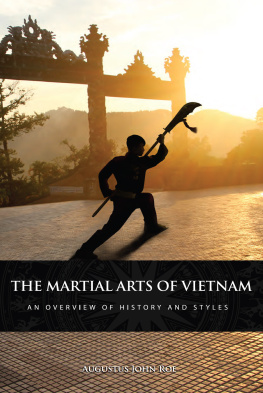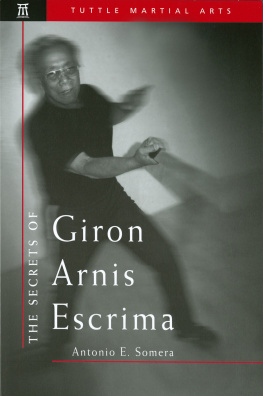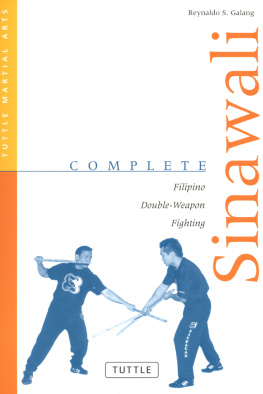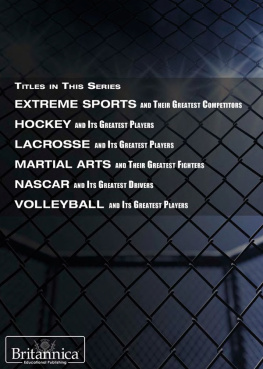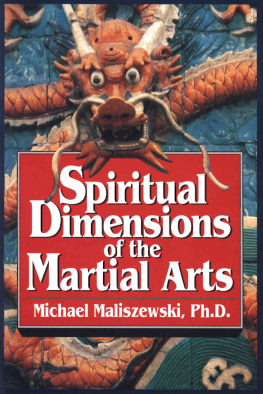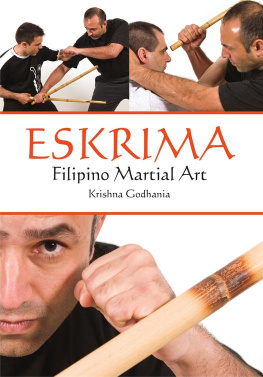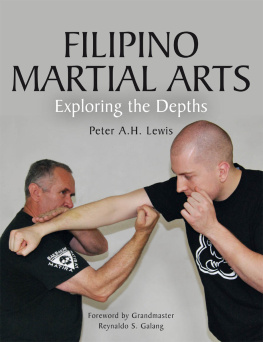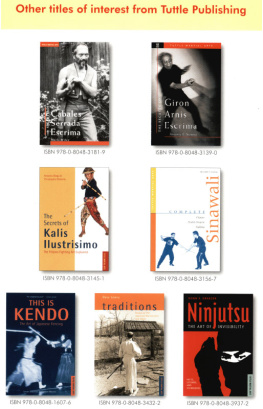Cover
Half Title
Title

Copyright
This edition published in 2001 by Tuttle Publishing, an imprint of Periplus Editions (HK) Ltd., with editorial offices at 364 Innovation Drive, North Clarendon, VT 05759 U.S.A.
Copyright 2001 by Mark V. Wiley
All rights reserved. No part of this publication may be reproduced or utilized in any form or by any means, electronic or mechanical, including photocopying, recording, or by any information storage and retrieval system, without prior written permission from Tuttle Publishing.
Library of Congress Cataloging-in-Publication Data
Arnis : history and development of the Filipino martial arts / compiled and edited by Mark V. Wiley.1st ed.
p.cm.
Includes bibliographical references.
ISBN: 978-1-4629-0742-7 (ebook)
1. Martial artsPhilippinesHistory. I. Wiley, Mark V.
GV1100.76.A2 A75 2001
796.8'09599dc21 00-069070
Distributed by
North America
Tuttle Publishing USA
364 Innovation Drive
North Clarendon, VT 05759-9436
Tel : (802) 773 8930
Fax : (802) 773 6993
Japan
Tuttle Publishing Japan
Yaekari Building 3rd Floor, 5-4-12
Osaki Shinagawa-ku,
Tokyo 141-0032
Tel: 81 (03) 5437 0171
Fax 81 (03) 5437 0755
Asia Pacific
Berkeley Books Pte. Ltd.
61 Tai Seng Avenue, #02-12
Singapore 534167
Tel: (65) 6280 1330
Fax: (65) 6280 6290
Email: inquiries@periplus.com.sg
Web site: www.periplus.com
05 04 03 02 01 00 9 8 7 6 5 4 3 2 1
Printed in the United States of America
Table Of Contents

C ONTENTS
by Felipe P. Jocano, Jr.
by Dr. Ned Nepangue
by joma B. Rivera
by J. Christoph Amberger
by Mark V. Wiley
by Rene J. Navarro, Dipl. Ac.
by Krishna K. Godhania
by Mark V. Wiley
by Antonio E. Somera
by Krishna K. Godhania
by Mark V. Wiley
by Thomas M. Kiefer, Ph.D.
by Marilitz Dizon
by Dr. Ned Nepangue
by Dr. Jopet Laraya
by Krishna K. Godhania
by Mark V. Wiley
by Pedro Reyes
by Mark V. Wiley
by Krishna K. Godhania
by Abner G. Pasa
by Felipe P. Jocano, Jr.

I NTRODUCTION
For centuries, Filipino martial arts have played integral and often history-changing roles in the Philippines and the survival of the Filipino people. But what are these arts? From where do they come? How have they developed across time and place? Where are they headed? And what inner dimensions do they offer their practitioners, if any? These questions, among others, form the basis of this collected volume of essays on Filipino martial arts in general, and arnis in particular.
This book was conceived with the notion of bringing together practitioners and writers on Filipino martial arts from the Philippines, North America, and Europe, thus offering many perspectivesnot all of which agree. But scholarship is not so much about developing agreeable theories as it is about putting forth new ideas in light of recent research findings. Indeed, one of the primary difficulties people have in coming to terms with the true history, development, and meaning of the Filipino martial arts is the pure dearth of written documentation on die arts. Aside from oral tradition mainly grounded in myth and legend, there is very little available in terms of historically and anthropologically grounded reference material, especially from Filipinos themselves. Moreover, it appears that much of what is written on arnis by Filipinos has been written by Filipinos who either relocated to or were born in North America and are rewriting what they read of arnis by Western authors and combining that with what they recall of their cultural traditions.
It wasn't until the mid-1970s, when Alexander Co published Martial ArtsMagazine in Greenhills, Philippines, that Filipinos had an accessible vehicle in which to publish articles about their arts. However, this publication mainly focused on East Asian martial arts, since these were more popular in the Philippines at the time. The magazine soon went out of print.
And so, it wasn't until nearly twenty years had passed, when Daniel Go began publishing RAPID Journal, that the Philippines had another vehicle at their disposal in which to publish their own voice on these arts. And while originally RAPID Journal (which stands for "Research and Propagation of Internal Arts Development") focused on internal disciplines (mainly Chinese), the past few years has seen an increasing inclusion of material on Filipino systems. Sadly, this magazine remains local to the Philippines and has not met the eyes of many Western practitioners, of which there are thousands. It is in this volume, then, that a number of the articles that first appeared in RAPID on Filipino martial arts are being published in a forum that will reach a world-wide audience of readers, writers, and researchers.
With this in mind, the articles that were written specifically for this collected volume, and those that were compiled from other sources, have been organized according to parameters set by discussion topic. The book, then, is divided into five parts, each offering multiple essays and perspectives on various aspects of the origin, history, and development of arnis.
Part One, "Origin Perspectives," sets the tone by offering four essays on the possible origins of the Filipino martial arts. Felipe Jocano's article, "A Question of Origins," examines many of the origin myths currently surrounding the art of arnis. Jocano examines these myths in terms of an anthropological and archaeological framework, putting to rest many theories and shedding light on others.
This is followed by Ned Nepangue's presentation of fact and fiction with regard to the origins of eskrima and its supposed connection with the so-called art of kali.
Conversely, in "The Origins of Traditional Silat in the West Philippines," Joma Rivera examines the supposition that Filipino silat (an art that many hold as the forerunner of arnis) comes from Indonesia or Malaysia, as opposed to being a product of the Filipino people themselves.
But do the martial arts of any given country necessarily have to come from those of another country? J. Christoph Amberger suggests they do not. In his essay "Eskrima, Spanish Rapier, and the Lost Continent of Mu," Amberger examines the current thoughts on diffusionism in martial art histories in general and on the assumed Spanish influence on arnis in particular.
Considering the arguments of the previous articles, and reflecting his personal research, Mark Wiley discusses the art of arnis in terms of what may be "pure" or indigenous to the Philippines, what was possibly brought to the Philippines from outside sources, and how the Filipino has crafted his fighting arts to fit his own times and needs.



